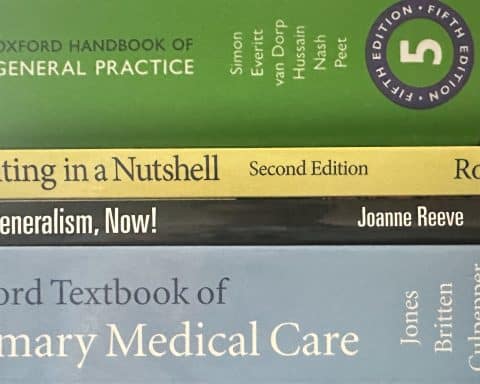Rhys Jenkins is a Pharmacist for City Health Cluster, Swansea Bay University Health Board, Swansea.
Kirsty Lanyon is a Trial Assistant on the project and based at Swansea University Medical School, Swansea.
Gail Holland is responsible for governance oversight for the project and based at Swansea University Medical School, Swansea.
Hayley A Hutchings is Project Chief Investigator based at the Swansea Trials Unit, Swansea University Medical School, Swansea.
Atrial fibrillation (AF) is a common cardiac arrythmia with an estimated global prevalence of between 0.4% and 1%.1 In 2017, a total of 287 200 AF-related deaths were reported — an increase of 47.8% from 2007.2 The prevalence of AF continues to rise and is thought to greatly affect quality of life (QoL) for patients.3 AF can be managed in several ways, including with oral anticoagulation therapy (OAT), which reduces the risk of stroke. A known side effect of anticoagulants is an increased risk of bleeding occurrence, which could be a heavy burden for patients with AF to manage.
To further investigate whether bleeds affect QoL in patients with AF, researchers from Swansea conducted a study that looked at the feasibility of recruiting those with an AF diagnosis who had recently experienced a bleed to collect QoL data. Three recruitment pathways were explored: primary care in Welsh general practice surgeries; secondary care in a local health board; and via a public survey link on the UK Arrythmia Alliance forum website.
Recruitment took place during the COVID-19 pandemic where lockdown restrictions were placed on UK residents. Non-COVID-related research studies conducted during this period were deemed lower priority and research task forces were delegated to higher priority COVID-19 workloads. The effect on our feasibility study was significant and we subsequently closed our secondary care site shortly after opening due to predicted low numbers of eligible patients and staff moving to COVID-related activities. Here we provide a narrative reflecting on the experience of recruiting patients to the study over lockdown via the primary care setting, with insight from a GP cluster pharmacist who supported study recruitment during the height of the pandemic.
“Recruitment took place during the COVID-19 pandemic … The effect on our feasibility study was significant … “
Following ethical approval, eight general practices within the City Health Cluster in Swansea Bay University Health Board recruited patients between February and December 2021. GP surgeries distributed letters to all identified patients who were currently prescribed OATs with expression of interest forms to return. The central cluster pharmacist also screened and identified eligible patients from practice databases during routine contact according to specific inclusion/exclusion criteria outlined in the study protocol.4
Typically, all anticoagulated patients would attend their respective surgeries in person for their anticoagulation reviews. Patients prescribed warfarin would occasionally attend weekly for their point-of-care testing (POCT) of international normalised ratio (INR) with the practice nurse. Direct oral anticoagulated (DOAC) patients would normally attend annually for a face-to-face review or in some cases every 3 or 6 months, depending on patient factors such as the need to monitor renal function.
The initial recruitment plan for primary care sites was three-fold. First, initial identification of patients was achieved by using surgery IT systems (EMIS or VISION) to electronically search for anticoagulated patients with AF. Second, patients were identified/recruited as they attended routine INR tests if prescribed warfarin. Lastly, DOAC patients attended the surgery for their DOAC reviews and surgery staff were prompted to mention the study to all suitable patients.
Once consented by their healthcare professional, STU researchers then followed up with the patient to minimise workload burden as much as possible for each of the general practice surgeries during the pandemic. Participants of the study were provided a participant information sheet and a choice of completing the survey online, via telephone, or on paper.
“There were several challenges faced across each of the recruitment pathways … “
Unfortunately, there was a high incidence of participants who had initially agreed to be involved subsequently declining to take part once followed-up by STU researchers. Recruitment issues were regularly discussed at study steering committee meetings and alternative approaches were suggested on an ongoing basis.
One possible solution was to send out a study recruitment letter directly to all anticoagulated patients in the hope that those experiencing bleeds would express interest in taking part in the study and contact the trials unit for further information if they had experienced a bleed. To achieve this and incentivise the surgeries to send out recruitment letters, STU were able to cover expenses and reimburse associated costs. The letters prompted some eligible patients to volunteer themselves for the study, as DOAC patient reviews may not have been due for a while.
Another approach applied was direct provision of a ‘participant pack’, which included the patient information sheet, consent form, and all required paper-based surveys to eligible patients on consent by the healthcare professional. This process eliminated the need for further contact from STU and reduced the possibility that the participant would subsequently decline.
There were several challenges faced across each of the recruitment pathways, namely difficulty identifying and recruiting patients through secondary care sites due to lack of suitable patients identified via medical database searches and difficulty in achieving the expected response rate on the online forum, which had been observed for other similar surveys.
“Most participants … indicated that they had been contacted via primary care sites.”
However, it was confirmed that recruitment efforts in primary care settings during this period were proficient, particularly from the cluster pharmacist, who identified many patients who were suitable for the study and willing to participate when compared with secondary care settings and the online forum.
Most participants who were recruited and who completed data collection indicated that they had been contacted via primary care sites; however, it was noted that primary care sites were more likely to recruit participants who reported minor bleeds. Major bleeds were reported infrequently in primary care.
Another limitation faced was the change in the way anticoagulated patients in primary care were managed over lockdown restrictions. Initially, there was a significant switch from warfarin to DOAC treatment. As such, designated conversion clinics were run in each anticoagulation surgery to reduce footfall in the surgeries, with patients attending for POCT INR monitoring. Reducing face-to-face INR monitoring reduced the risk of airborne coronavirus transmission in waiting rooms, but it meant that patients who could have potentially been highlighted for the study were not as frequently in contact with their surgeries.
Eventually, guidance allowed GP surgeries to continue DOAC reviews during the pandemic, but where possible a telephone review should be conducted. The uptake to telephone DOAC reviews was hindered due to several reasons.
First, in Spring/Summer 2021 there was a nationwide shortage of blood sample bottles. As a result of this, routine blood tests were halted and only blood tests that were deemed to be ‘urgent’ were warranted in primary care.
“… primary care was deemed to be successful in terms of gathering interest and identifying patients over lockdown restrictions.”
Second, GP surgeries had historically been used to receiving enhanced service payments for conducting DOAC reviews. In 2020, enhanced service payments continued at an estimated value only, extrapolated from claims made prior to the pandemic. Surgeries received payment but were not required to make specific claims, which potentially resulted in less incentive to increase the amount of DOAC reviews that were conducted compared with, on average, the amount pre-pandemic. However, patients were ultimately able to be recruited to the study if bleeding was discovered as part of their telephone DOAC review.
DOAC reviews are timely, so getting through the vast number of reviews was a lengthy process. All but one surgery relied solely on one cluster pharmacist to conduct their DOAC reviews, which involved high workload pressures alongside assisting with study recruitment.
Lastly, the overall structure and day-to-day running of primary care and GP surgeries changed completely when COVID-19 hit, not only for clinical staff but for administrative staff also, which had an impact on the organisation of chronic condition reviews and their urgency in comparison to the other challenges that surgeries were faced with. Once surgeries began returning to carrying out their chronic condition reviews, there was naturally a large backlog to be tackled.
Overall, despite several unavoidable limitations, primary care was deemed to be successful in terms of gathering interest and identifying patients over lockdown restrictions.
Funding
The Chief Investigator of the study was Hayley A Hutchings, Swansea Trials Unit, Swansea University. Under the UK Policy Framework for Health and Social Care Research, Swansea University met the requirements of research governance sponsor. Bristol-Myers Squibb and Pfizer funded the research, and under the UK policy framework were part of a partnership that accepted overall responsibility for proportionate and effective arrangements to be in place to set up, run, and report the research project. They were represented on the Trial Steering Committee throughout the project.
References
1. Liu GJ, Wang YF, Chen PY, et al. The efficacy and safety of novel oral anticoagulants for the preventive treatment in atrial fibrillation patients: a systematic review and meta-analysis. Drug Deliv 2014; 21(6): 436–452.
2. GBD 2017 Causes of Death Collaborators. Global, regional, and national age-sex-specific mortality for 282 causes of death in 195 countries and territories, 1980-2017: a systematic analysis for the Global Burden of Disease Study 2017. Lancet 2018; 392(10159): 1736–1788.
3. Aliot E, Botto GL, Crijns HJ, Kirchhof P. Quality of life in patients with atrial fibrillation: how to assess it and how to improve it. Europace 2014; 16(6): 787–796.
4. Hutchings HA, Lanyon K, Lister S, et al. Investigating the feasibility of recruitment to an observational, quality-of-life study of patients diagnosed with atrial fibrillation (AF) who have experienced a bleed while anticoagulated: EQUAL-AF feasibility study protocol. Pilot Feasibility Stud 2022; 8(1): 180.
Featured photo by Miikka Luotio on Unsplash.








